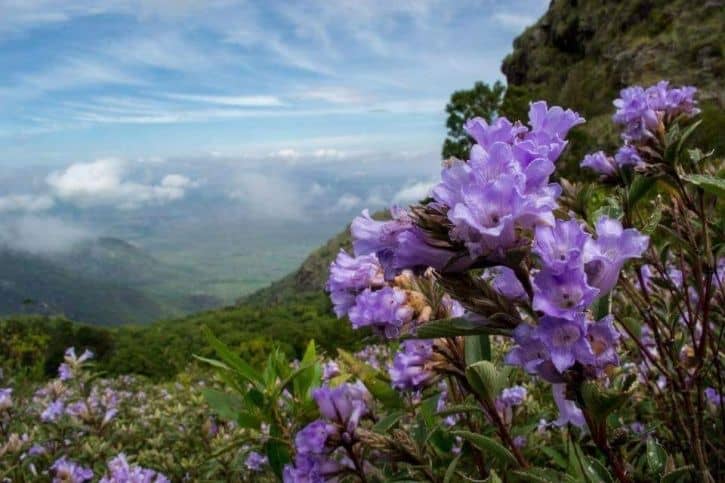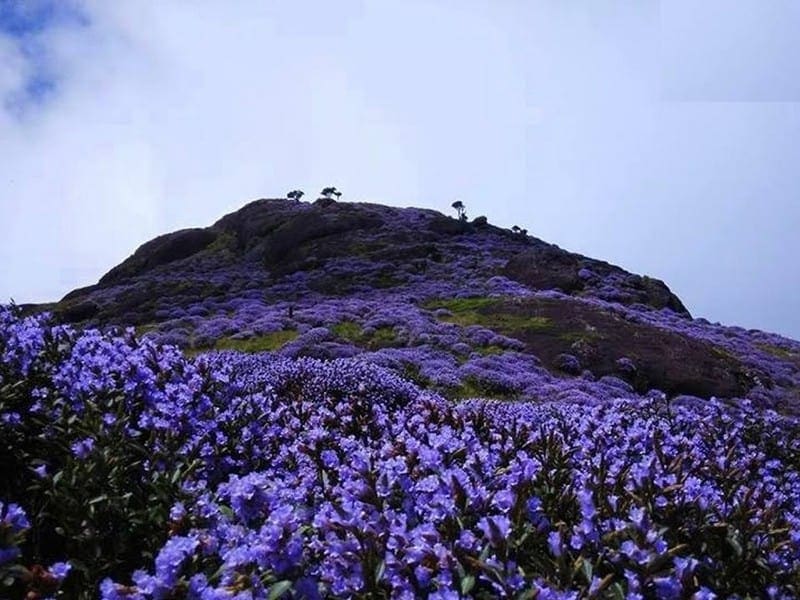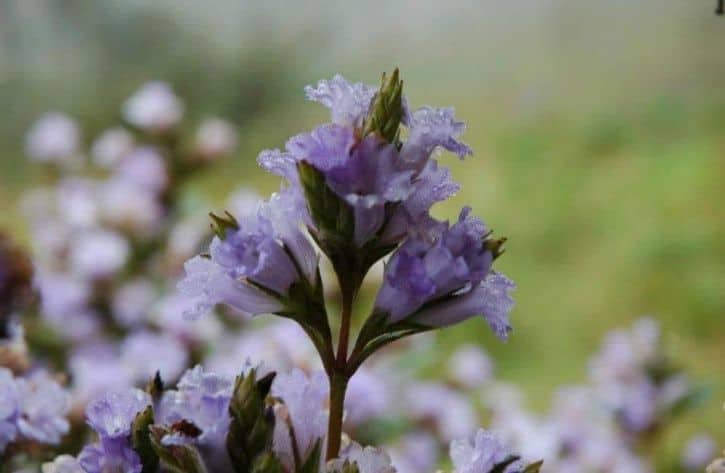That time of the decade has come; the time nature lovers and travel buffs have been waiting for. After 12 long years, Neelakurinji bloom is set to return to the valley, mountains, and slopes of majestic Munnar. The last bloom took place in 2018 when social media were in their infant stage and not so popular. In 2018, travellers celebrated the bloom on social media, attracting and inviting globetrotters all over the world and that is one of the reasons which Lonely planet included Munnar as #4 among the best places to visit in Asia in 2018.

Munnar is a Mecca for every travel junkie; every traveller must have experienced the charm of Munnar, the chill of its hills, the lush green valleys, the silvery streams, the cascading waterfalls, captivating plantations, and every other bit of Munnar. But not many would have experienced the legendary Neelakurinji bloom in Munnar, as it takes 12 years to bloom.
What makes the Neelakurinji flower blooming in Munnar so special?
There is a multitude of blooming valleys and flower-laden grasslands all over the world, but there are many factors that make Munnar and its Neelakurinji unique and stand out. The peculiarity of Munnar Neelakurinji is its exclusivity. Neelakurnji blooms take place only in Munnar. Although the plants are found in a sparse amount in other south Indian hill stations, the one in Munnar is profuse, sprawling magically across the green mountains of Munnar.
The Neelakurinji plants are camouflaged into the thick vegetation of Munnar and they go unnoticed during off-seasons. During the bloom season, the Neelakurinji flowers take the center stage in Munnar. The proliferating azure flowers turn the place ethereal and the sight of the valley decked in blue is too spectacular to be true.
ALSO, SEE – How to Plan a Trip from Bangalore to Munnar?
When to visit Munnar for Neelakurinji Blooming?
As mentioned earlier, the Kurinji blooms every 12 years; the second last known bloom was in 2006, the last bloom was be in 2018 and next bloom in 2030, which will be followed by a flowering season in 2030 and so on. If you wish to descry the blue wonderment, 2018 would be the right time. The Neelakurnji flowering season coincides with the spring season of Kerala. The Kurinji flowers start flowering in limited numbers in the last phase of the monsoon. As the monsoon clouds slowly recede, the blue florets carpet the valleys, mountains, and grasslands. The blooming season starts in August and ends in November. The peak blooming period would be in September and October.

If you want to visit a place where it is less crowded and noisy, the beginning of the flowering season would be ideal for you. As the flowering progresses, it is more likely to spread across social media, attracting more crowds to the hills. If you yearn to witness the bloom in all its glory and if you don’t mind the crowd and the hullaballoo, the peak months of September and October will suit you the best.
Neelakurinji last bloom was between August 2018 November 2018.
Here are some facts about the Kurinji poo or Neelakurinji flower as it is locally known and flowers that will help you to better enjoy and appreciate the bloom. The prime attracting factor of the flower is its eye-soothing blue colour. When the flower ages, it turns purplish-blue. The Kurinji flowers grow in places of high altitudes with a chilly climate. It grows at an altitude of 1300 to 2400 meters. The plant Neelakurinji plant falls in the shrub category and is usually 30 to 60 cm high, but it can grow well beyond 180 cm under amiable environmental conditions.
ALSO SEE – Experience Customised Munnar Sightseeing Packages
Restrictions in Munnar for Kurinji Flower Blooming
You can book tickets online at munnarwildlife.com and eravikulamnationalpark.org. There will be restrictions on the number of entry tickets to Eravikulam national park during the Kurinji season and only 3500 tickets can be booked. You can book tickets online or you can book at offline centres in Munnar KSRTC Station or Marayoor Forest Office.
There are proposals from the Forest Department in front of the State Government that tourist buses coming from major roads should be stopped from entering Munnar town. Two-wheelers & cars will be stopped at Old Munnar from where shuttle service will be provided by Government. Only tourists with entry tickets to Eravikulam national park will be allowed.
Even though Neelakurinji was supposed to have been blooming in June 2018, because of the late monsoon, the blooming will mostly occur started in the first week of August 2018 and you can book tickets on the official website of Munnar Tourist Division or Eravikulam National Park. 75% of ticket booking for Neelakurinji will be online and the rest will be through offline counters in Munnar. Ticket Rates are 120 INR for Adults and 90 INR for Children from India. Foreigners will have to pay 400 INR and the camera also has an entry fee.

Some more Kurinji facts
- Neelakurinji flowers are not just the light blue flowers we see. There are 250 different species of Kurinji and 46 varieties of Neelakurinji are found in India; it even includes red, maroon flowers but Neeakurinji is most famous.
- The flower is popularly known as Neelakurinji and it is a Malayalam word that simply means blue flower. The scientific name of Neelakurinji is Strobilanthes kunthianus. The name is derived from the River Kunthi which nourishes the expanse of the renowned many grasslands and valleys.
- The word Nilgiri means ‘blue mountains’ and the famed Nilgiri mountains get their name from the carpeting blue Neelakurinji flowers.
- The nectar collected in Munnar during Neelakurinji season is believed to be very special taste-wise and nutrition-wise. The honey bees in the areas mostly collect the nectar from Neelakurinji flowers during the season, as it is found in abundance.
- The people belonging to the Paliyan of Tamil Nadu used the Neelakurinji flowers as a reference to calculate their age.
- The flower attracts bees and is a heavy source of honey and nectar and honey from the flower is believed to have medicinal properties
- There are two cycles of Neelakurinji Season in Munnar and shorter season occurred on 2014. However, the last season in 2018 is the most popular season which ensures blooming over 3500 hectares
How to Plan your visit to Neelakurinji Bloom in Munnar?
If you are planning to visit Munnar during the Kurinji season, it is ideal to make the stay arrangements as soon as you can. The flowering is a much-anticipated tourism event in Kerala and the Government has already started promoting the event. The hotels and resorts in Munnar and expected to be fully booked even months before the blooming starts. So if you have the plan, make the move before it is too late.
The same goes for travel arrangements. Unless you are travelling in your own vehicle; the buses or cars or whatever modes of transport you prefer, book it in advance.
Make sure that you visit the place during the dawn. During the early morning, the mist blankets the valleys and the plants making it look like a piece of Paradise. As the sun rises, sending millions of invigorating sun rays to the valleys, there will be a beautiful melody of chill and warmth. As the morning progresses the sun rays melt the mist to form dew all over the Neelakurinji flowers.
Taking a walk through the Neelakurinji laden grasslands is a spell-binding experience. Don’t make your trip to Munnar one day even if you are a few hours away from the place. Stay for at least a day in Munnar and make sure that you relish the grandeur of the bloom in the backdrop of mist and a saffron sun.
If you are allergic to flowers pollens, bees or anything relating to flowering take necessary precautions before visiting. Take vaccination shots prior to the trip and pack your anti-allergens and antihistamines without fail.
When you visit the place, be a responsible tourist. Do not pick the flowers or plants, it is for everyone to enjoy. There could be retribution for damaging the plants or disturbing the biodiversity, the Government is planning to deploy volunteers to ensure that the plants are not destroyed and the vandals are punished.
Updated Later- Please note that Munnar is safe to visit from September 1, 2018, after the Kerala floods and all resorts and hotels are open for guests. The infrastructure work has also been completed and you can schedule your visit anytime before November 2018.
